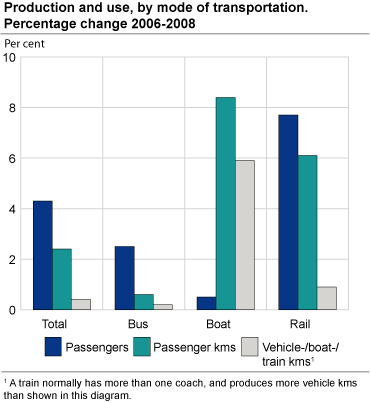Content
Published:
This is an archived release.
Steady growth in public transport
The number of passengers who travelled by bus, boat and rail increased by 4.3 per cent from 2007 to 2008. Rail passengers accounted for most of the growth, but also the number of bus passengers increased.
In 2008, the number of public transport fares added up to 473 million, an increase of 4.3 per cent from 2007. The increase was strongest for suburban railways, urban tramways and for the Airport Express train (9.5 per cent).
The number of passengers travelling by rail increased by almost 8 per cent from 2007 to 2008. The corresponding growth in the number of bus passengers was around 2.5 per cent. There was no change in the number of passengers travelling by boat.
Despite more use of public transportation, both vehicle-/train kilometres and seat kilometres came out almost unchanged from 2007. There was, however, an increase of 5.9 per cent in boat kilometres, even though there was no change in the number of passengers.
Longer fares by boat and shorter trips in the cities
Average length of fares by boat rose from less than 25 kilometres in 2007 to above 27 kilometres in 2008. In major cities, average length of fares by bus fell from eight kilometres in 2007 to six kilometres in 2008.
Strong public effort
Subsidies to all public transportation but train, increased by almost 22 per cent from 2007 to 2008.
Unsteady comparability over timeBoth the boat and the bus sector have faced major changes in structure, technology and types of contracts. These changes make it difficult to compare figures over time. |
Tables:
Contact
-
Jardar Andersen
E-mail: jardar.andersen@ssb.no
tel.: (+47) 99 70 08 04

